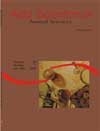<b>Molecular characterization of ruminal bacterial diversity in vitro</b> - DOI: 10.4025/actascianimsci.v30i2.4699
Abstract
PCR analysis is a sensitive and specific tool to detect and monitor microorganisms in complex environmental samples. The amplification of 16S ribosomal DNA sequences followed by gel electrophoresis under denaturing gradient (DGGE) has been a powerful technique to genetically evaluate microbial ecosystems. Changes in rumen microbial populations were investigated in vitro using a basal diet with different lipid sources. PCRs were performed with two different sets of primers in order to amplify 16S rRNA sequences, and the amplified fragments were submitted to DGGE analysis. The findings presented in this study show that distinct microbial communities were present in each treatment. The presence of soybean oil seems to maximize growth of bacterial population, whereas fish oil appears to reduce growth. We demonstrated the successful application of molecular ecological techniques to analyze the structure and composition of bacterial communities in rumen ecosystems.Downloads
Download data is not yet available.
Published
2008-08-07
How to Cite
Freitas, K. C., Gabriel, J. E., Leite, L. C., Armas, R. D. de, Lanna, D. P. D., & Madeira, H. M. F. (2008). <b>Molecular characterization of ruminal bacterial diversity in vitro</b> - DOI: 10.4025/actascianimsci.v30i2.4699. Acta Scientiarum. Animal Sciences, 30(2), 187-192. https://doi.org/10.4025/actascianimsci.v30i2.4699
Issue
Section
Ruminant Nutrition
DECLARATION OF ORIGINALITY AND COPYRIGHTS
- I Declare that current article is original and has not been submitted for publication, in part or in whole, to any other national or international journal.
The copyrights belong exclusively to the authors. Published content is licensed under Creative Commons Attribution 4.0 (CC BY 4.0) guidelines, which allows sharing (copy and distribution of the material in any medium or format) and adaptation (remix, transform, and build upon the material) for any purpose, even commercially, under the terms of attribution.
Read this link for further information on how to use CC BY 4.0 properly.
0.9
2019CiteScore
29th percentile
Powered by 








































